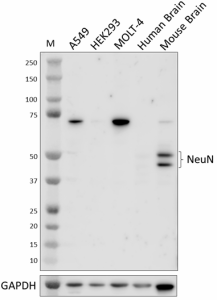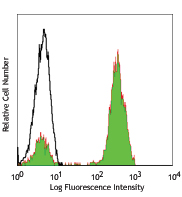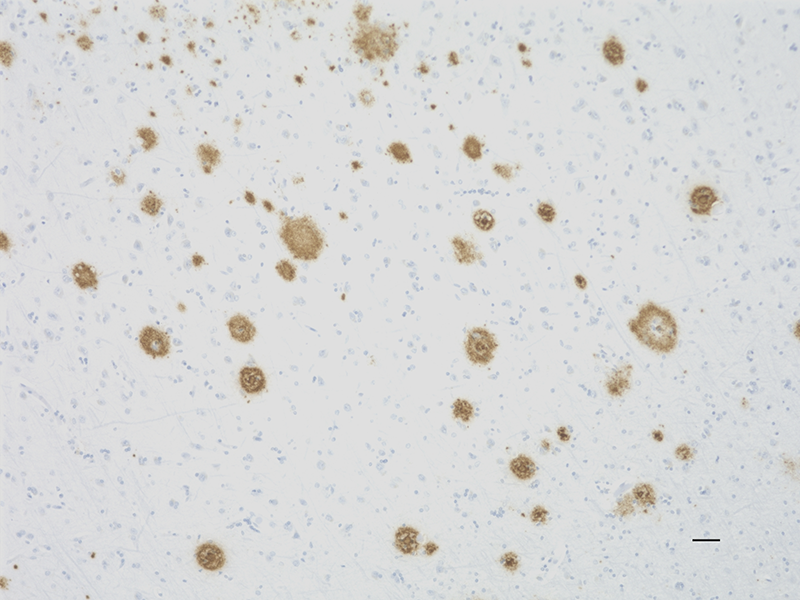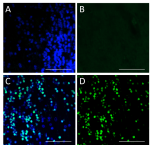- Clone
- W18230A (See other available formats)
- Regulatory Status
- RUO
- Other Names
- NeuN, RNA binding protein fox-1 homolog 3 (RBFox3), hexaribonucleotide binding protein 3, HRNBP3
- Isotype
- Rat IgG2a, κ
- Ave. Rating
- Submit a Review
- Product Citations
- publications

-

Whole cell extracts (15 µg total protein) from the indicated cell lines were resolved on a 4-12% Bis-Tris gel, transferred to a PVDF membrane, and probed with 1 µg/mL (1:500 dilution) of purified anti-RBFox3 (NeuN) (clone W18230A) overnight at 4°C. Proteins were visualized by chemiluminescence detection using HRP goat anti-rat IgG (Cat. No. 405405) at a 1:3000 dilution. Direct-Blot™ HRP anti-GAPDH (Cat. No. 607904) was used as a loading control at a 1:50000 dilution. Western-Ready™ ECL Substrate Plus Kit (Cat. No. 426317) was used as a detection agent. Lane M: Molecular weight marker -

IHC staining of purified anti-RBFox3 (NeuN) (clone W18230A) on human cerebellum tissue. Tissue was fixed with Fixation Buffer (Cat. No. 420801), blocked with 5% FBS plus 5% Normal Blocking Serum (Cat. No. 927503), and incubated with 10.0 µg/mL of purified rat IgG2a, κ isotype control (Cat. No. 400501) (panel A) or 10.0 µg/mL of the primary antibody (panel B) overnight at 4°C. This was followed by incubation with Alexa Fluor® 647 goat anti-rat IgG (Cat. No. 405416) at 2.5 µg/mL. Nuclei were counterstained with DAPI (blue) and the slide was mounted with ProLong™ Gold Antifade Mountant. The image was captured with a 40X objective. Scale bar: 50 µm -

IHC staining of purified anti-RBFox3 (NeuN) (clone W18230A) on mouse brain tissue. Tissue was fixed with Fixation Buffer (Cat. No. 420801), blocked with 5% FBS plus 5% Normal Blocking Serum (Cat. No. 927503), and incubated with 10.0 µg/mL of purified rat IgG2a, κ isotype control (Cat. No. 400501) (panel A) or 10.0 µg/mL of the primary antibody (panel B) overnight at 4°C. This was followed by incubation with Alexa Fluor® 647 goat anti-rat IgG (Cat. No. 405416) at 2.5 µg/mL. Nuclei were counterstained with DAPI (blue) and the slide was mounted with ProLong™ Gold Antifade Mountant. The image was captured with a 40X objective. Scale bar: 50 µm
| Cat # | Size | Price | Quantity Check Availability | Save | ||
|---|---|---|---|---|---|---|
| 608451 | 25 µg | 95€ | ||||
| 608452 | 100 µg | 278€ | ||||
RBFox3, commonly referred to as NeuN, is one of a family of 3 mammalian Fox homologues. Fox was discovered in C. elegans as a gene involved in sex determination, and the name RBFox is an acronym of "Feminizing locus on X". The Fox protein and its 3 mammalian homologues are all about 46 kD proteins, each of which includes a central highly conserved RRM type RNA recognition motif, which corresponds to a small ~70 amino acid structure consisting of 4 beta strands and two alpha-helices. RBFox3 is a protein which has a function in RNA splicing and is expressed heavily and specifically in neuronal nuclei. The antibody reveals strong nuclear and distal cytoplasmic staining for RBFox3/NeuN and the complete absence of staining of astrocytes and other kinds of non-neuronal cells. This RBFox3/NeuN antibody is therefore an excellent marker of neuronal cells.
Product DetailsProduct Details
- Verified Reactivity
- Human, Mouse
- Antibody Type
- Monoclonal
- Host Species
- Rat
- Immunogen
- Full length recombinant human RBFOX3, isoform 5
- Formulation
- Phosphate-buffered solution, pH 7.2, containing 0.09% sodium azide
- Preparation
- The antibody was purified by affinity chromatography.
- Concentration
- 0.5 mg/mL
- Storage & Handling
- The antibody solution should be stored undiluted between 2°C and 8°C.
- Application
-
WB - Quality tested
IHC-P, IHC-F - Verified
SB - Community verified - Recommended Usage
-
Each lot of this antibody is quality control tested by western blotting. For western blotting, the suggested use of this reagent is 0.125 - 1.0 µg/mL. For immunohistochemistry on formalin-fixed paraffin-embedded tissue sections, a concentration range of 1.0 - 10.0 µg/mL is suggested. For immunohistochemistry on frozen tissue sections, a concentration range of 1.0 - 10.0 µg/mL is suggested. It is recommended that the reagent be titrated for optimal performance for each application.
- Application Notes
-
This antibody was tested by ICC using NTERA2 cells (positive control) and HEK293 cells (negative control). While robust staining was observed in the positive cell line, background staining was observed in the negative cell line therefore it is not recommended to use this antibody in ICC application.
This antibody was tested for ICFC using A549 cells (positive control) and A431 cells (negative control). Testing was conducted using both Cyto-Fast™ Fix/Perm Buffer Set (Cat. No. 426803) and True-Nuclear™ Transcription Factor Buffer Set (Cat. No. 424401). No shift in signal in the positive cell lines was observed with either buffer set. We do not recommend this clone for ICFC testing.
Western Blot testing was conducted using lysates from human cell lines, human brain, and mouse brain. Bands of expected molecular weight were only observed in the mouse brain lysate. This antibody does not recognize human NeuN in western blot. - Additional Product Notes
-
This product has been verified for IHC-F (Immunohistochemistry - frozen tissue sections) on the NanoString GeoMx® Digital Spatial Profiler. The GeoMx® enables researchers to perform spatial analysis of protein and RNA targets in FFPE and fresh frozen human and mouse samples. For more information about our spatial biology products and the GeoMx® platform, please visit our spatial biology page.
- RRID
-
AB_2927957 (BioLegend Cat. No. 608451)
AB_2927957 (BioLegend Cat. No. 608452)
Antigen Details
- Structure
- RBFox3 is a 312 amino acid protein with a predicted molecular weight of 34 kD
- Distribution
-
Mature Neurons, Neural Stem Cells/ Cytoplasm and Nucleus
- Function
- Cell Biology, Neuroscience, Neuroscience Cell Markers, Stem Cells
- Cell Type
- Mature Neurons, Neural Stem Cells
- Biology Area
- Cell Biology, Neuroscience, Neuroscience Cell Markers, Stem Cells
- Molecular Family
- Nuclear Markers
- Antigen References
-
- Dhekne HS, et al. 2018. Elife. 7:e40202.
- Sun Y, et al. 2020. J Neuroinflammation. 17:72.
- Schwabenland M, et al. 2021. Immunity. 54:1594-1610.
- Gene ID
- 146713 View all products for this Gene ID
- UniProt
- View information about RBFOX3 on UniProt.org
Related Pages & Pathways
Pages
Related FAQs
- If an antibody clone has been previously successfully used in IBEX in one fluorescent format, will other antibody formats work as well?
-
It’s likely that other fluorophore conjugates to the same antibody clone will also be compatible with IBEX using the same sample fixation procedure. Ultimately a directly conjugated antibody’s utility in fluorescent imaging and IBEX may be specific to the sample and microscope being used in the experiment. Some antibody clone conjugates may perform better than others due to performance differences in non-specific binding, fluorophore brightness, and other biochemical properties unique to that conjugate.
- Will antibodies my lab is already using for fluorescent or chromogenic IHC work in IBEX?
-
Fundamentally, IBEX as a technique that works much in the same way as single antibody panels or single marker IF/IHC. If you’re already successfully using an antibody clone on a sample of interest, it is likely that clone will have utility in IBEX. It is expected some optimization and testing of different antibody fluorophore conjugates will be required to find a suitable format; however, legacy microscopy techniques like chromogenic IHC on fixed or frozen tissue is an excellent place to start looking for useful antibodies.
- Are other fluorophores compatible with IBEX?
-
Over 18 fluorescent formats have been screened for use in IBEX, however, it is likely that other fluorophores are able to be rapidly bleached in IBEX. If a fluorophore format is already suitable for your imaging platform it can be tested for compatibility in IBEX.
- The same antibody works in one tissue type but not another. What is happening?
-
Differences in tissue properties may impact both the ability of an antibody to bind its target specifically and impact the ability of a specific fluorophore conjugate to overcome the background fluorescent signal in a given tissue. Secondary stains, as well as testing multiple fluorescent conjugates of the same clone, may help to troubleshoot challenging targets or tissues. Using a reference control tissue may also give confidence in the specificity of your staining.
- How can I be sure the staining I’m seeing in my tissue is real?
-
In general, best practices for validating an antibody in traditional chromogenic or fluorescent IHC are applicable to IBEX. Please reference the Nature Methods review on antibody based multiplexed imaging for resources on validating antibodies for IBEX.
Other Formats
View All RBFOX3 Reagents Request Custom Conjugation| Description | Clone | Applications |
|---|---|---|
| Purified anti-RBFOX3 (NeuN) | W18230A | WB,IHC-P,IHC-F,SB |
| Alexa Fluor® 647 anti-RBFOX3 (NeuN) | W18230A | IHC-P,IHC-F |
| Alexa Fluor® 488 anti-RBFOX3 (NeuN) | W18230A | IHC-F,IHC-P |
Customers Also Purchased




Compare Data Across All Formats
This data display is provided for general comparisons between formats.
Your actual data may vary due to variations in samples, target cells, instruments and their settings, staining conditions, and other factors.
If you need assistance with selecting the best format contact our expert technical support team.
-
Purified anti-RBFOX3 (NeuN)

Whole cell extracts (15 µg total protein) from the indicated... 
IHC staining of purified anti-RBFox3 (NeuN) (clone W18230A) ... 
IHC staining of purified anti-RBFox3 (NeuN) (clone W18230A) ... -
Alexa Fluor® 647 anti-RBFOX3 (NeuN)

IHC staining of Alexa Fluor® 647 anti-RBFOX3 (NeuN) (clone W... 
IHC staining of Alexa Fluor® 647 anti-RBFOX3 (NeuN) (clone W... -
Alexa Fluor® 488 anti-RBFOX3 (NeuN)

IHC staining of Alexa Fluor® 488 anti-RBFOX3 (NeuN) (clone W... 
IHC staining of Alexa Fluor® 488 anti-RBFOX3 (NeuN) (clone W...
 Login / Register
Login / Register 







Follow Us